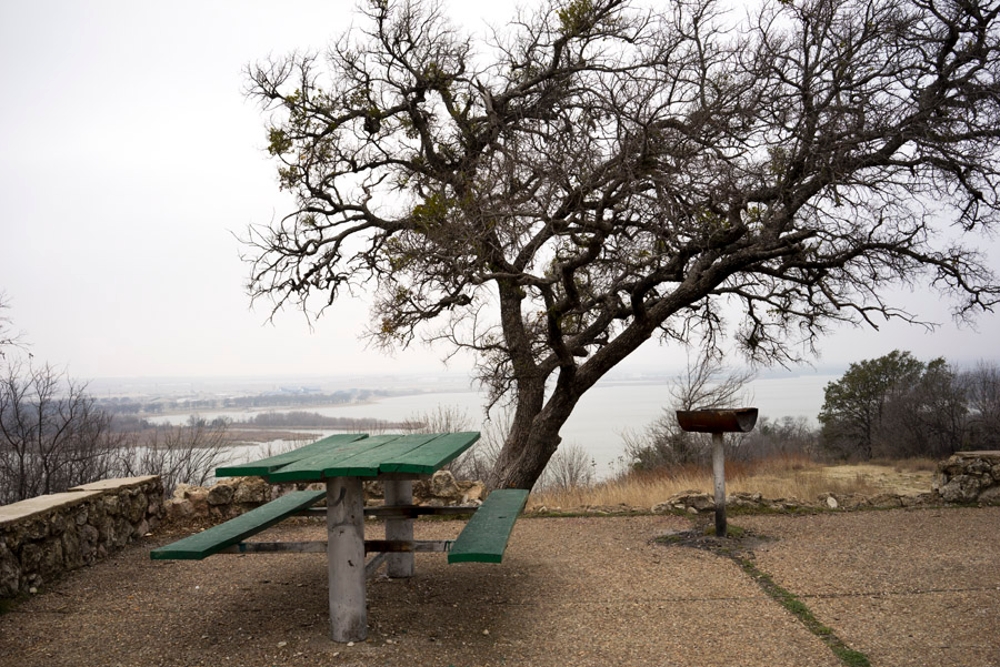Terry Evans
(American, b. 1944; resides in Chicago, IL)
Terry Evans is well-known for exploring vast landscapes and rural expanses in North America through projects that have documented locations including virgin prairie, working steel mills, the Kansas Flint Hills, and the oil boom in North Dakota. Evans particularly focuses on how people use the land, paying special attention to the intersection of natural forces and human development. In her recent series, Meet Me at The Trinity (2013-2014), she explores the Trinity River as it passes through Fort Worth, Texas. The Trinity is Texas’s single longest river and is an important waterway that has a long history of human intervention. Beginning in 1928, the river’s West fork and Elm fork were moved into new, engineered river beds, constituting Dallas’s largest public works project to date. Moving the Trinity River significantly altered the landscape and now prevents flooding in low lying areas of the region while also more efficiently supporting farming, transportation, and urban development. These changes have also dramatically impacted the ecosystems of the area and, over the past century, the waters of the river have become increasingly polluted due to runoff containing pesticides and herbicides as well as human and industrial waste.
Evans' involvement with the Trinity River began with a commission from the Amon Carter Museum of Art in Fort Worth, Texas in conjunction with an exhibition of paintings and drawings by the mid-19th century painter George Caleb Bingham. Upon first arrival, Evans was struck by the unattractive appearance of the heavily engineered and polluted landscape, one that is very different from the idyllic landscapes in Bingham’s paintings which focus on daily life along the Missouri River during American westward expansion. Despite the state of the Trinity, Evans found that locals interact with the river in ways comparable to the subjects depicted in Bingham’s paintings as they gather along the waterway for recreation, relaxation, and work. In Meet Me at the Trinity, Evans chooses to focus on the activities of the residents by portraying them fishing the channeled river, swimming in inner tubes, and attending concerts and festivals on its banks. Also included in the series are images of infrastructure and large-scale construction projects where the size of industrialized control over natural resources stands in contrast to Bingham’s paintings. Paying close attention to Bingham’s work and mirroring the painter’s approach to pose, gesture, and light, Evans has photographed the life of a modern community gathering at the riverbed alongside the highly engineered landscape that has shaped its course. Often photographing from her signature aerial vantage point, Evans captures the intimacy and conviviality of the crowd drawn to a familiar place and observes the human attraction to waterways, even those which have been engineered.
Born in Kansas City, Missouri, Terry Evan’s completed her BFA in Painting at the University of Kansas (1968). Recent one-person exhibitions of her work include Fractured: North Dakota’s Oil Boom at the Field Museum of Natural History, Chicago, IL (2013 and 2014) and Heartland, a retrospective exhibition organized by the Nelson-Atkins Museum of Art, Kansas City, Missouri in 2012, which traveled to the Snite Museum at Notre Dame, Indiana in 2013. Recent books include, Heartland: The Photographs of Terry Evans (2012) and Prairie Stories (2012). Evans is a Guggenheim Fellow (1996) and a recipient of an Anonymous Was a Woman fellowship (2006). Her work is included in the permanent collections of the Art Institute of Chicago, the Museum of Modern Art, New York City, San Francisco Museum of Modern Art, and the Whitney Museum of American Art, among others.
https://www.terryevansphotography.com/





